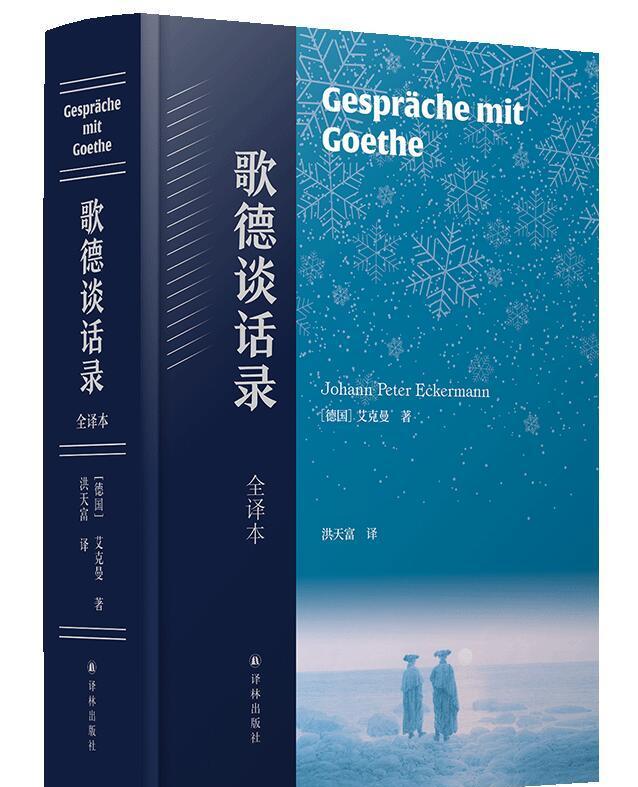Modern Express News (reporter Zheng Wenjing) Recently, Nietzsche's "Goethe's Talks", which was praised by Nietzsche as the best work of German prose literature, was launched in full translation by the Translation Forest Publishing House.

As one of Germany's greatest writers and recognized giants of world literature, Goethe is an indispensable figure when understanding German and even European literature and culture, and to truly understand Goethe, in addition to his own works such as "The Troubles of Young Werther" and "Faust", he is also inseparable from this "Goethe Talk". This work by the German poet Ekmann records in detail The deeds and thoughts of Goethe in his last years, presenting his multi-dimensional life in various fields such as literary creation, philosophical thinking, artistic exploration, scientific research and even affairs management, which can be called an authoritative first-hand document for understanding Goethe.
In 1823, the young Ekman, who had read a large number of Goethe's poems and regarded Goethe as his guide, could not restrain his "sincere love and reverence for Goethe", and almost came to Weimar, the city where Goethe lived, almost with a pilgrimage mentality. At this time, Ekman was 31 years old, and Goethe was 74 years old, entering the final journey of his life.
The following nine years were a period of mutual achievement for the two men: the master poured out his life experience and instructed the young people to improve their literary accomplishment and spiritual realm; the young people fully assisted the master in his work, while observing the details, silently recording the master's last life deeds and the thoughts and speeches that shone with wisdom.
It is with the help of Ekman's records that we can see another Goethe, three-dimensional and vivid, profound and interesting.
In 1836, four years after Goethe's death, Eckman compiled and published Goethe's conversations and activities recorded in his journey with Goethe in two volumes. As he says in the preface, Ekman had good intentions for such a work —"to advocate and spread all kinds of good things." Obviously, he hoped that the ideas of Goethe, the great man, would be known to more people. Although in these two volumes Ekman faithfully records many important moments in the nine years from his meeting with Goethe on June 10, 1823, to his farewell to Goethe's body in March 1832, this is not all his recollection.
Thus, after 12 years, Ekman published a third volume of this talk, supplementing the first two volumes; this volume has another peculiarity: in addition to his own records and memories, it also includes a large number of Goethe's talks recorded by the Swiss Soller. Soler came to Weimar a year before Eckman, and was also closely associated with Goethe and was well versed in the natural sciences.
There are many Chinese translations of Goethe's Talks, but most of them are selected. The full translation launched by the Translation Forest Publishing House was directly translated by Hong Tianfu, a senior translator at Nanjing University, from German, and was completely included in the original three volumes with a total of 325 texts, in addition to Goethe's own literary creation and literary and artistic thoughts, it presented more content: Goethe's interaction with the European literary and artistic circles, such as Schiller, Byron, Scott and other famous artists; Goethe's in-depth exploration of science, such as plant deformation and color science; how Goethe managed affairs, such as university construction and theater management; what emotional past did Goethe have when he was young. How to experience the pain of bereavement and loss of children in old age; and so on. All of this shows that Goethe is not just a writer, but a comprehensive and true "man" who extends infinitely in many dimensions of life.
In addition, Ekman's preface to the two publications and his long preface are also included in the volume, which shows the first half of Ekman's perseverance and curiosity in the thirty years before he met Goethe.
In order to help readers systematically understand this huge work, the translator specially wrote a 20,000-word long afterword, carefully sorted out in thousands of clues, and summarized the themes of the book from multiple angles such as world outlook and ideological methods, political outlook, literary and artistic outlook, world vision, and literary creation.
The edition also includes 20 masterpieces by Caspar David Friedrich, a pioneer of German Romantic painting who was praised by Goethe for depicting German objects of high beauty and profound allegory, to some extent revealing where the great soul lived. (Courtesy of publisher)